Bishapur, Relief IV
Relief IV
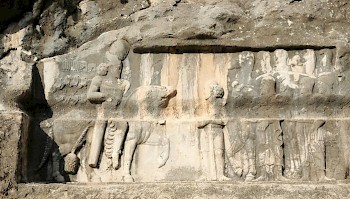
The fourth Sasanian rock relief at Bishapur - chronologically, the fifth - was made for king Bahram II (r.276-294) and shows how he receives a delegation of Arabs. This relief is very interesting because it is the only Sasanian monument that shows an embassy. The envoys are brought to the king by a Persian nobleman with a long sword. The fact that it is an Arab embassy is a testimony of the fact that this nation was becoming better organized, and commanded sufficient respect to be recognized as allies by the Sasanian kings.
Something similar happened in the Roman Empire, where the oasis of Palmyra, together with a federation of Arabs, created an empire of its own, which held out as a buffer between Rome and the Sasanians from 260 to until 272. The Sasanians and Romans would increasingly often use Arab tribal warriors. The rise of Islam was still in the future, but the first signs of the expanding power of the Arabs were there.
The Arabs are recognizable on this relief because they are accompanied by a dromedary. There's also a horse. (Camels are absent, which is one indication that this animal was still uncommon.) King Bahram II can be recognized by looking at his winged crown.
We do not know what subject the king of kings discussed with the Arab ambassadors, nor do we know which tribe(s) they represented. However, in the West, the Romans were stronger than they had been in a long time, and it is possible that the Arabs were invited to join the war. If so, it did not work out well: in 287, Bahram was defeated by the Roman emperor Diocletian, the Sasanians lost control of Armenia, and Bahram never managed to recover what he had lost.
Like two other monuments on the north side of the Tang-e Chowgan gorge, the fifth relief was damaged when an aqueduct of stone was constructed along the rock. This was removed in the 1970s.
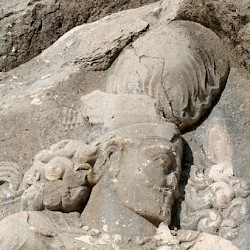 Bishapur, Relief 4, Bahram II |
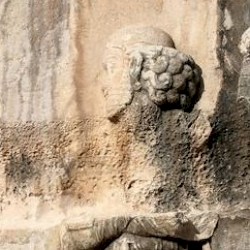 Bishapur, Relief 4, Persian guide of the Arab embassy |
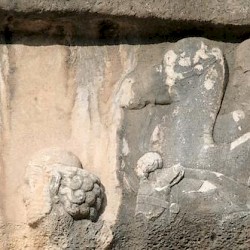 Bishapur, Relief 4, Arab embassy with dromedary |
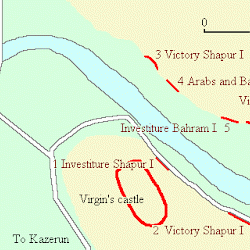 Map of Bishapur's Reliefs |
Literature
Louis Vanden Berghe, Reliefs rupestres de l' Iran ancien (1983 Brussels), #69.